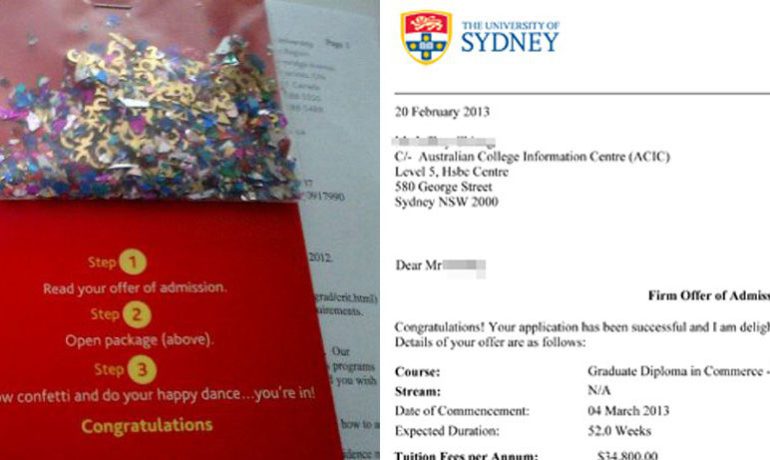A young woman in Chennai, India is delighted beyond measure when she learns she has been made an offer to study in a well-regarded Australian university. Her family are equally excited and they hold a celebratory dinner that evening in her honour, with her parents, grandparents, aunts, uncles, brothers, sisters, nephews and cousins all sharing in the reflected glory of her achievement. Her success was no accident – it came on the back of years of hard work; long days and nights of study fuelled by a determination to succeed, not just for herself, but also for her loved ones.
Days turn into weeks, weeks into months, and she hears nothing from the university. One day another offer to study pings in her email, this time from a reasonably prestigious Canadian university. She is delighted again, but, burnt by experience, resigns herself to another long wait for more information, or just some plain old human contact saying well done, we’re as happy as you are that you want to study at our university.
However, the resignation doesn’t last long. After just a few days the university is in touch. It has more than thanks to offer. It wants to fly her, along with other would-be students in her country, on a charter flight to Canada to have a look around, to check out the college, to talk to the professors and to meet other students who will share their experiences of life at the university.
At which university will she choose to study? The Australian, or the Canadian? The answer is obvious.
The scenario sketched above is not an abstraction. It is a concrete example of what is happening right now to and within Australian universities, which are among the best in the world except, with some exceptions, when it comes to student recruitment policies.
There is absolutely no room or excuse for complacency in student recruitment. Right now, Australia is the third most popular destination for overseas students, attracting nearly seven per cent of the world’s international cohort. It is, to put it bluntly, a $32 billion industry – Australia’s fourth largest export, following iron ore, coal and gold. But other countries are catching up. They are utilising savvy and proactive marketing and recruitment practices to stake their claims and in the process are attracting students in places where, until recently, Australia believed it had something of a monopoly. Not any more.
It is our view – drawn from our experience in international recruitment – that if our institutions are to remain at the front of the pack in this increasingly competitive environment they must urgently reconsider the structure of their recruitment programs.
These must now cater to all stages of the student degree purchasing cycle.
Marketing campaigns that drive enquiry through to application alone – the typical Australian model – have passed their use-by date. To sustain and boost acceptance rates, institutions now urgently need to increase investment in the post-offer period of their recruitment programs. In other words, they should nurture and care for their prospective students from offer to acceptance to the day the student attends his or her first lecture – and, of course, beyond.
The good news for Australian universities is that the dynamism of digital has made post-offer marketing more effective than ever. Advances in technology and applications means the Internet, if used wisely, is your best friend.
To stay on the front foot post-offer we recommend three marketing “Musts”:
- Act rather than wait during the post-offer phase of the purchasing cycle
- Position the offer as the peak of your campaign, rather than its conclusion
- Employ off-campus incentives over financial concession to promote acceptance
1. Act rather than wait during the post-offer phase of the purchasing cycle
The prospective student buying cycle for a higher education degree, an expensive and highly-emotionally involved decision, resembles that of a car or house purchase. It is no surprise, therefore, that it takes on average 12 months from the initial contact by the university for a student to accept, with awareness commencing years before.
During this time the students’ decision-making process undergoes at least three distinct stages:
- Enquiry through to Application
- Application through to Offer
- Offer through to Acceptance
Each stage represents a shift in the needs and nature of the relationship between the Education Institution and the prospective student.
All three of these stages are dependent on and related to each other as marketing objectives – yet in almost all Australian universities they are held to independent performance metrics.
This is a serious disjuncture, but as will be shown, one that is entirely remediable.
Most commonly, international recruitment efforts prioritise and maximise investment in the first two stages, which involve sophisticated and complex programs whose efficacy is judged on and rewarded by enquiry and application success criteria.
And so a critical gap emerges in the relationship with the prospective student. For by the time the offer goes out recruitment staff, through no fault of their own, but rather because of the system they work to, have peaked in their performance and feel they have completed their job. Many are burnt out.
Consequently, and crucially, the relationship with the student goes quiet during the Offer through to Acceptance, or post-offer, stage of the campaign.
In this digital era it is never a good idea to go off-line, especially when acceptance can take up to three months following an offer. Given that today’s students weigh up multiple offers, often, as we have seen, from competitive institutions in multiple countries, the post-offer stage must not be regarded as downtime.
Rather it should be seen for what it is – an important high-stakes marketing battleground.
2. Position the offer as the peak rather than the end of a campaign
Marketing to the point when the student is made an offer is relatively straight- forward for experienced practitioners. This is because an offer from a university marks a prestigious milestone in a person’s life. It is an event. It is something to be proud of, to celebrate and, importantly, to share with family and friends. The would-be student is emotionally committed and highly desires the offer.
Typically, what happens next is that a sedate letter or email is sent informing the prospective student that their application has been successful. There is no fanfare, no frills or thrills. In the best case the student is congratulated. In the worst case the student is handed an offer with an expiry date with no other explanation or clarification. It seems to imply – act now, or else …
With no reason to act otherwise the student files the offer letter among others in an inbox or desk pile. The courtship leading up to the offer fizzles out. The recruitment team waits to hear from the student. The student responds as and when it suits them.
This is all wrong. Offer time is crucial – it is exactly when the marketing and recruitment teams should be exerting themselves to nurture the relationship with the prospective student.
The phase needs to be seen in a new light – as the peak of a student recruitment campaign. It is the ideal time to differentiate the brand and to secure the relationships the institution has worked so hard to acquire.
Real-world examples illustrate how on-the-ball universities have prospered because they understand the importance of the offer phase.
For instance, the University of Florida invites students to respond live to their offer via social media. Couple years ago during the seconds, minutes and hours after students received offers they used #UF17 on Twitter and Instagram to interact directly with the university, share their joy and broadcast their news.
Closer to home an Australian university that has made the marketing shift personalises a URL. The web page congratulates the student and showcases personalised information they may need prior to acceptance. This information is far from flat; it is personalised and interactive. Video content by student name, Facebook and Twitter integration and tailored Social Content Feeds make the Personalised URL, or “PURL,” a vibrant introduction to university life.
We can testify personally for its success: the campaign boasts a 70% open rate across all recipient categories with 32 of 1200 offers accepted directly out of the email.
In both cases the institution is perfectly positioned to engage with students’ first reactions to their offer. The hard-won relationship is kept alive as the institution responds to the good and sometimes bad in a personalised manner in real time. The student is less likely to file away the offer. They are more likely to differentiate it from the pack and place it at the top of their pile of options.
3. Employ off-campus rather than financial incentives to promote acceptance
It is well understood that students carefully consider factors such as ranking and financial commitments when deliberating an offer. However, equally important are off-campus factors. For starters there is the city and country in which the university is located, followed closely by the quality and certainty of the lifestyle, accommodation, safety, support services, accessibility and job opportunities.
These all play into the offer and contribute significantly to the post-offer decision process leading to acceptance.
Yet student recruitment campaigns continue to do what they have always done – rely on rankings and dip into the kitty. University offer acceptance is encouraged through the tired tricks of discounting fees or providing additional incentives to agents, while simultaneously ignoring the concrete advantages of a range of highly sought-after off-campus assets often sitting on the doorstep.
These efforts ignore the student mindset – imagining themselves in another country, an adventure of exploration and discovery that stretches beyond the confines of the lecture hall. Students understand that they are committing themselves to live in a place for several years – a vital aspect of why students choose international education in the first place.
In Australia there is no excuse for such neglect. The breadth of off-campus advantage and incentive is breathtaking.
Our major cities are world class and the country – mountains, wilderness, bushland, beaches – is stunning. Universities are based in cosmopolitan, safe cities where every effort is made to support students’ language, cultural and accommodation needs. They offer a high degree of quality and certainty both on and off- campus.
As an example of such natural marketing incentives, two noted Australian universities are using off-campus benefits to successfully drive acceptance.
In 2014 the University of Tasmania gave away a seaplane tour over Hobart to those that accepted early, taking in views of the Botanical Gardens, Tasman Bridge and Kingston Beach and the possibility of dolphin spotting. The metrics prove its worth – early acceptance numbers are twice the rate. Similarly, our team also developed for a Sydney-based university gifted a Sydney Bridge Climb, achieving double-digit early acceptance rates.
These post-offer incentives work on several levels. They enhance the relationship with the student by helping them to visualise themselves at an institution where they are succeeding academically and enjoying themselves.
They promote a wide range of off-campus advantages without having to spell them out. Furthermore they yield for marketers and recruiters much film footage that can be used over again to start and strengthen relationships with prospective students.
In summary, it is crucial that institutions act during the post-offer stage of the future student purchasing cycle. Recruitment campaigns underpinned by digital that position the offer as a highpoint and drive acceptance by promoting off-campus assets are proven to succeed.
Better still these efforts provide much needed opportunities for universities to authentically bring to life brand values post-offer that set them apart from the competition.If doing great post-offer marketing sounds like what you want to do, just get in touch with us today and let us help you with that.


